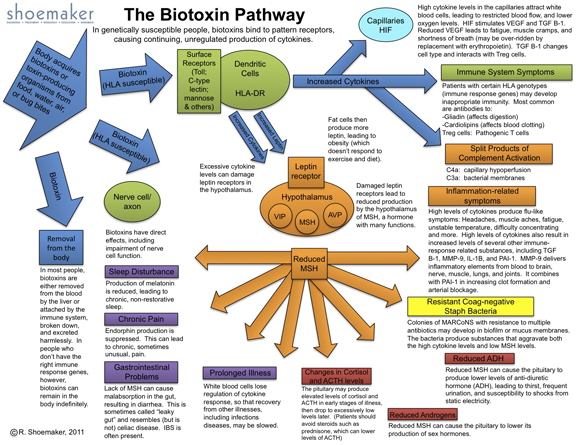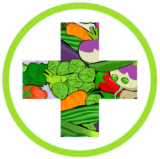
The topic of biotoxin illness can be very confusing for individuals that do not specialize in the field, for instance- do you know what the difference is between HERTSMI and HLA-DR? This CIRS definitions page includes words and phrases commonly used when talking about Chronic Inflammatory Response Syndrome and other biotoxin illnesses. Since this topic of study is still developing, some terms are used interchangeably on the internet and printed material even though their differences are noteworthy. We hope you find this resource helpful, as you navigate the maze of symptoms and solutions. Although the MFM team devotes many hours of research time, gaps may exist in this document and we always appreciate learning how to improve. To offer a suggestion and stay informed about the latest information and recipes- please join the community here to receive our monthly newsletter!
Glossary of CIRS related terms and Definitions
Amylase: not to be confused with amylose; amylase is an enzyme, found chiefly in saliva and pancreatic fluid, that converts starch and glycogen into simple sugars.
Amylose definition: the crystallizable form of starch, consisting of long unbranched polysaccharide chains. As it relates to Mold Illness: Dr. Shoemaker, a leader in biotoxin illness research strongly suggests a low or no amylose diet as part of the illness treatment protocol as it has shown to be very helpful in supporting recovery. (see low amylose diet definition alphabetically below) References: https://www.healingmoldsickness.com/the-no-amylose-diet https://www.survivingmold.com/docs/CIRS_Essay_on_the_Shoemaker_Protocol_Oct17_Louise_Carder.pdf
Anti inflammatory diet/foods: foods that actively reduce inflammation in the body as opposed to potentially triggering an immune system response and associated health risk from chronic inflammation. Examples of common anti inflammatory foods are: fresh leafy vegetables, salmon, and berries. reference https://www.mayoclinic.org/healthy-lifestyle/nutrition-and-healthy-eating/in-depth/how-to-use-food-to-help-your-body-fight-inflammation/art-20457586 – great erference for the argument of why to eat a mold free menu diet! And this too: https://www.health.harvard.edu/staying-healthy/foods-that-fight-inflammation
Atkins also known as Atkins diet: a diet high in protein and fat and low in carbohydrates, prescribed for weight loss, refined by Dr. Robert C. Atkins. Similar to Keto diet. Similar to Paleo Diet and AIP Diet Ref: https://www.medicinenet.com/script/main/art.asp?articlekey=24581
Autoimmune disease definition: A condition in which the body’s immune system mistakes its own healthy tissues as foreign and attacks them. Most autoimmune diseases cause inflammation that can affect many parts of the body. The parts of the body affected depend on which autoimmune disease a person has. Common signs and symptoms include fatigue, fever, muscle aches, joint pain and swelling, skin problems, abdominal pain, digestion problems, and swollen glands. The symptoms often come and go and can be mild or severe. Ref: https://www.cancer.gov/publications/dictionaries/cancer-terms/def/autoimmune-disease
Biotoxin Illness – see CIRS and Environmentally Acquired Illness
Biotoxin Pathway — “…the pathway a biotoxin takes in our body which results in a cascade of symptoms.” From K. D. Jognson MD. See chart image below for illustration originally developed by Dr. Shoemaker.
Biotoxin Pathway — see Shoemaker Protocol

Black mold definition: a fungus also known as Stachybotrys chartarum that has been the topic of many health related lawsuits. It is greenish black and commonly found in water damaged buildings. According to the CDC, even though mold has not been ‘proven’ as a cause of health problems (similar to early cigarette smoking studies) , it is clearly stated that: “ Stachybotrys chartarum and other molds may cause health symptoms that are nonspecific. It is not necessary to determine what type of mold you may have growing in your home or other building.”
Candida: any of a genus (Candida) of parasitic fungi that resemble yeasts, occur especially in the mouth, vagina, and intestinal tract where they are usually benign but can become pathogenic, and have been grouped with the imperfect fungi but are now often placed with the ascomycetes – Miariam webster https://www.merriam-webster.com/dictionary/candida. Also known as Candidiasis. a fungal infection due to any type of Candida (a type of yeast). When it affects the mouth, it is commonly called thrush. … More than 20 types of Candida can cause infection with Candida albicans being the most common – https://en.wikipedia.org/wiki/Candidiasis
Chronic Fatigue Syndrome (CFS): is a complicated disorder characterized by extreme fatigue that can not be explained by any underlying medical condition. The fatigue may worsen with physical or mental activity, but doesn’t improve with rest. Common CIRS symptom. Reference: https://www.mayoclinic.org/diseases-conditions/chronic-fatigue-syndrome/symptoms-causes/syc-20360490, https://www.prohealth.com/library/can-mold-cause-chronic-fatigue-syndrome-is-mold-a-breakthrough-or-just-a-false-lead-5433
CIRS: Chronic Inflammatory Response Syndrome: is a multi system, multi symptom complex illness with a collection of symptoms that can mimic those associated with other conditions like Lyme Disease, Ehrlichiosis and some AutoImmune Disorders. CIRS may often be misdiagnosed, or under diagnosed.
According to Dr. Shoemaker’s website, the CIRS definition is: “an acute and chronic, systemic inflammatory response syndrome (a group of characteristic symptoms) acquired following exposure to the interior environment of a water-damaged building with resident toxigenic organisms, including, but not limited to fungi, bacteria, actinomycetes and mycobacteria as well as endotoxins, beta glucans, hemolysins, proteinases, mannans and possibly spirocyclic drimanes; as well as volatile organic compounds”.
Mold Illness, and was initially thought to be caused by mold exposure only. However, further research indicates bacteria, fungus and various viral infections are also implicated in the development of Chronic Inflammatory Response Syndrome.
Other terms commonly interchanged with CIRS:, “Mold Illness”, “mold sickness”, “biotoxin illness”, “immunologic disease”, “mold toxicity”, “Water Damaged Building sickness ‘WBD’”, and “Environmentally Acquired Illness”.
From NIHA. More information here: https://www.nihadc.com/health-programs/chronic-inflammatory-response-syndrome-cirs.html also add to resources in general is one persons journey: http://biotoxinjourney.com/what-is-biotoxin-illness/
Elimination diet: is an eating plan that omits a food or group of foods believed to cause an adverse food reaction, often referred to as a “food intolerance.” By removing certain foods for a period of time and then reintroducing them during a “challenge” period, you can learn which foods are causing symptoms or making them worse. https://www.fammed.wisc.edu/files/webfm-uploads/documents/outreach/im/handout_elimination_diet_patient.pdf
Environmentally Acquired Illness aka EAI: Exposure to toxins or substances in the environment that cause illness. CIRS is one example of environmentally acquired illness. Common sources of EAI include mold & biotoxin exposure, tick bites (lyme disease), exposure to volatile organic compounds aka VOC’s or chemical pesticides (multiple chemical sensitivity (MCS), asbestos exposure, lead poisoning, polluted drinking water, etc.Non-environmentally acquired illnesses can worsen when exposed to environmental toxins. Also known as Environmental Disease, and Environmental Illness https://me-pedia.org/wiki/Environmentally_acquired_illness
Food allergy: An allergy occurs when your body’s natural defenses overreact to exposure to a particular substance, treating it as an invader and sending out chemicals to defend against it. It is an immune response. Common symptoms include one or more of these: hives, stomach cramps, vomiting, pale skin, wheezing, cough, shortness of breath, swelling of the tongue, hoarse throat, and anaphylaxis. The symptoms may be mild on one occasion and may cause more severe symptoms at another time. Common foods causing allergies: dairy, eggs, tree nuts, peanuts, shellfish, wheat, soy, fish, and to a lesser degree avocado/kiwi/chamomile. https://acaai.org/allergies/types/food-allergy https://www.healthline.com/nutrition/common-food-allergies#section11
Food sensitivity: also known as food intolerance: similar symptoms of food allergy, but food sensitivity/intolerance is triggered by the digestive system. Also known as non-IgE mediated food hypersensitivity or non-allergic food hypersensitivity. Symptoms include: bloating, headaches, hives, cough, nausea, migraines, heartburn, irritability, and rashes. Typically a few hours after eating. Commonly caused by these foods: dairy, gluten, caffeine, fermented foods, FODMAPs, sulfites, eggs, food coloring and yeast.
https://www.medicalnewstoday.com/articles/263965#causes, https://cellsciencesystems.com/education/research/inflammatory-symptoms-immune-system-and-food-intolerance-one-cause-many-symptoms/ https://www.healthline.com/nutrition/common-food-intolerances#section4
HERTSMI test: often associated with ERMI test. The ERMI (Environmental Relative Moldiness Index) test is a dust sampling analysis offered by several labs to evaluate the health of a building. ERMI uses a DNA-based method for identifying 36 different species of mold. A smaller version of this test, the HERTSMI (also called the HERTSMI-2), uses similar technology to identify and quantify five of the more common and toxic species of mold. https://momsaware.org/
GENIE test: Acronym that stands for: “Genomic Expression Inflammation Explained”. A blood test ordered by your healthcare professional through https://www.progenedx.com that determines which of the 188 genes related to CIRS and similar inflammatory conditions are active at the time of the test. The results may confirm ongoing biotoxin reactions or verify treatment was successful and biotoxin reactions are no longer occurring. Developed by Dr. Shoemaker.
HLA-DR: Human leukocyte antigen. One of the numerous antigens (substances capable of stimulating an immune response) involved in the major histocompatibility complex (MHC) in humans. When a person carries the HLA-DR gene, however, they are genetically susceptible to biotoxic illnesses because the HLA-DR causes a misprocessing of antigens, which inhibits the immune system from reacting correctly to infection and toxins. https://moldblogger.com/the-hla-dr-gene-and-mold-sensitivity/ https://www.ncbi.nlm.nih.gov/pmc/articles/PMC5554125/
Immunologic Disease – see CIRS
Ketogenic – “keto”, “keto diet”: A diet low in carbohydrates, with the primary source of calories from protein & fat. Similar to Paleo Diet and AIP Diet. Also see Atkins above.
Lectin avoidance diet: avoiding foods high in lectin. Examples of avoided foods: legumes, nightshade vegetables, dairy products, grains like barley, quinoa, and rice. Lectins are not digestible, and potentially interfere with nutrient absorption. Small amounts are part of a healthy diet for most. https://www.healthline.com/health/lectin-free-diet#negative-effects https://newsnetwork.mayoclinic.org/discussion/mayo-clinic-q-and-a-what-are-dietary-lectins-and-should-you-avoid-eating-them/
Low amylose diet: Similar to common low carb diets, but specifically eliminating foods that contain high concentrations of amylose. Read more here.
Lyme disease: an inflammatory disease characterized at first by a rash, headache, fever, and chills, and later by possible arthritis and neurological and cardiac disorders, caused by bacteria that are transmitted by ticks. Oxford dictionary.
MARCoNS (MultipleAntibioticResistantCoagulaseNegativeStaphylococci): is an antibiotic resistant staph that commonly resides deep in the nasal passage of 80% of people with low MSH (Melanocyte Stimulating Hormone), Biotoxin Illness and other chronic inflammatory illnesses like CIRS and CFIDS (Chronic Fatigue and Immune Dysfunction Syndrome). Though not officially recognized as a medical condition by many primary care physicians, it is commonly experienced among people suffering from biotoxin illness. http://www.functionalmedicineuniversity.com/MARCoNS.pdf
MMP9: is one of a class of zinc-dependent enzymes; normal levels in the body are extremely beneficial (stimulate the immune response, contributes to normal tissue growth, blood vessel creation, ovulation, wound healing, and bone formation.) High levels can break down the blood brain barrier. Elevated levels of MMP9 are common among conditions like: inflammatory conditions like CIRS and Lyme disease, Alzheimer’s, Lupus, cancer, IBD, Diabetes and others. https://www.frontiersin.org/articles/10.3389/fncel.2015.00280/full https://en.wikipedia.org/wiki/MMP9 https://selfhack.com/blog/mmp9/
Mold: A mold (US) or mould (UK / NZ / AU / ZA / IN / CA / IE) is a fungus that grows in the form of multicellular filaments called hyphae. In contrast, fungi that can adopt a single-celled growth habit are called yeasts. Examples of mold are: penicillin- a good mold, “black mold” aka Stachybotrys – a bad mold. Examples of mold that is beneficial to the natural environment but may cause harm when ingested: the molds that break down organic matter in garden compost creating fertile soil. Although molds can grow on dead organic matter everywhere in nature, their presence is visible to the unaided eye only when they form large colonies. The term “mold” when referring to Toxic Mold Exposure typically refers to a very wide variety of substances that often coexist- including fungus, bacteria, mold spores, and yeast. https://www.poison.org/articles/2011-oct/mold-101-effects-on-human-health https://blog.moldinspectionsciences.com/blog/posts/2019/05/good-mold-vs-bad-mold/ https://en.wikipedia.org/wiki/Mold
Mold allergy: similar to food allergies, mold allergies are the body’s damaging immune response to a substance that is harmless to some people. Inhaling toxic molds/fungus/bacteria can lead to CIRS, but CIRS is not an allergy. Common symptoms of a mold allergy are: runny nose, sneezing, wheezing, stuffy nose, shortness of breath, cough, rashes, fatigue, and headache.
Mold exposure: mold and toxic substances associated with mold entering the body by breathing invisible airborne particles. Dangerous mold exposure is most common in structures that have had water leaks or damage.
Mold sickness/mold illness: see CIRS above
Mold toxicity: see CIRS
Mycotoxin: Mycotoxins are naturally occurring (invisible to the unaided eye) toxins produced by certain molds/fungi and can be found in food, potentially causing a serious health threat to humans and livestock. Common mycotoxins are: aflatoxins, ochratoxin A, patulin, fumonisins, zearalenone and nivalenol/deoxynivalenol. Foods found to be contaminated with mycotoxins more often (typically as a result of storing these products for long terms in somewhat humid conditions) are: grains, dried fruit, coffee, nuts, and dried herbs. Minimizing the consumption of mycotoxins is extremely important for health https://www.who.int/news-room/fact-sheets/detail/mycotoxin https://www.who.int/news-room/fact-sheets/detail/mycotoxins
Paleo & Paleo Diet: a diet based on the types of foods presumed to have been eaten by early humans, consisting chiefly of meat, fish, vegetables, and fruit, and excluding dairy or grain products and processed food. Oxford dictionary . similar to Atkins, Keto, AIP.
‘Reaction to food’ when partaking in an elimination diet: experiencing symptoms like any listed in “food allergies” or “food intolerance”. Some common reactions are: congestion, pain, aches, digestive, fatigue, headaches.
Shoemaker Protocol: A specific series of treatment steps taken to remove biotoxins from the body, eradicate MARCoNS if present, correcting anti bodies/androgens/osmality, MMP9, C3 &4, TGF-B1, and VIP levels. Named after Dr. Shoemaker, but used my many medical professionals to resolve biotoxin illness in patients.
SIBO (Small Intestinal Bacterial Overgrowth) occurs when there are excess bacteria in the small intestine. This abnormal increase of the bacterial population may result in abdominal pain, bloating, and malabsorbtion. Common sub illness in CIRS patients. Not consistently eradicated with antibiotics.
Sick Building Syndrome, also known as SBS, BRI building related illness: The feeling of ill health comprised of various nonspecific symptoms that occur in the occupants of a building. https://www.ncbi.nlm.nih.gov/pmc/articles/PMC2796751/ https://en.wikipedia.org/wiki/Sick_building_syndrome
Vasoactive Intestinal Polypeptide (VIP) aka Low Vasoactive Intestinal Polypeptide: is a neuropeptide that functions as a neuromodulator and neurotransmitter. It is a potent vasodilator, regulates smooth muscle activity, epithelial cell secretion, and blood flow in the gastrointestinal tract. A nasal spray with the same name is commonly part of the treatment for CIRS, Lyme and biotoxin illness. https://www.uptodate.com/contents/vasoactive-intestinal-polypeptide
Wet building syndrome: see also Sick building syndrome and WDB definitions above.
ISEAI : The International Society for Environmentally Acquired Illness is a nonprofit professional medical society that aims to raise awareness of the environmental causes of inflammatory illnesses and to support the recovery of individuals affected by these illnesses through the integration of clinical practice, education, and research.
In summary, this resource of CIRS definitions was developed by the Mold Free Menu team to provide some clarity for those suffering from Chronic Inflammatory Response Syndrome. To learn more about each term, we strongly suggest you speak with a reputable biotoxin illness specialist. Keep detailed notes of your tests, symptoms, and results as you may need to refer to them when referencing this glossary of terms.
The information we provide at Moldfreemenu.com is intended to provide information to better understand how a healthy diet is part of healing from biotoxin illness and not intended to replace consultation with a qualified medical professional.Specific medical advice including diagnosis and treatment will not be provided. This diet does not cure mold illness but does help reduce inflammation- thus reduce symptoms triggered by inflammation.
A low amylose diet is beneficial for CIRS recovery according to Dr. Shoemaker. Elevated MMP9 levels can often be reduced by following a strict low or no amylose diet. Ask your health professional to monitor your bloodwork details.
- Free exclusive recipes
- Helpful product giveaways
- Latest news before it reaches the blog
- Supportive tips from the moldfreemenu community
Other posts you might be interested in:
Two most important First Steps in healing from mold illness
35 safe foods for CIRS and five to avoid completely
What is a Low Amylose diet and why follow it?
If you found the information here on the CIRS glossary and definitions page helpful, sign up for the monthly newsletter filled with the latest news & reader recipes!
